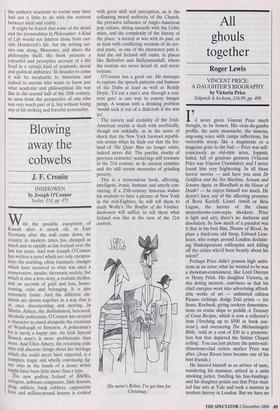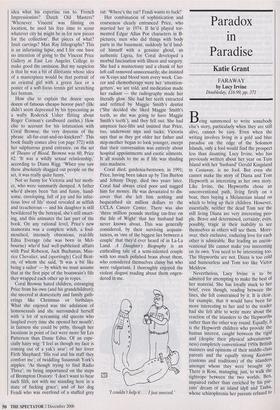All ghouls together
Roger Lewis
VINCENT PRICE: A DAUGHTER'S BIOGRAPHY by Victoria Price Sidgwick & Jackson, £16.99, pp. 498 Id never given Vincent Price much thought, to be honest. His viola-da-gamba profile, the natty moustache, the sinuous, sing-song voice with campy inflections, his venerable stoop, like a magistrate or a magician gone to the bad — Price was self- consciously an old-style actor, foppish, faded, full of gracious gestures (Vincent Price was Vincent Crummles); and I never found him very frightening. In all those horror movies — and have you seen Dr Goldfoot and the Sex Machine, Scream and Scream Again, or Bloodbath at the House of Death? — he enjoys himself too much. He doesn't have any of the affecting presence of Boris Karloff, Lionel Atwill or Bela Lugosi, the heroes of the classic monochrome-cum-sepia shockers. Price is light and airy; there's no darkness and desolation. So how much of a paradox was it that in his best film, Theatre of Blood, he plays a third-rate old thesp, Edward Lion- heart, who romps around London declaim- ing Shakespearean soliloquies and killing off the critics who'd been beastly about his talent?
Perhaps Price didn't possess high ambi- tions as an actor; what he wanted to be was a showman-connoisseur, like Lord Duveen or Henry Frick. His daughter Victoria, in this doting memoir, convinces us that his chief energies went into advertising afford- able works of art — unlimited edition Picasso etchings, dodgy Dali prints — for Sears, Roebuck, giving cookery demonstra- tions on cruise ships to peddle A Treasury of Great Recipes, which is now a collector's item ('fetching up to $500 at book auc- tions), and overseeing The Michaelangelo Bible, 'sold at a cost of $30 in a presenta- tion box that depicted the Sistine Chapel ceiling'. You can just picture the pants-suit- rhinestone-clad retiree market Price was after. (Joan Rivers later became one of his best friends.) He fancied himself as an arbiter of taste, wandering his mansion, attired in a satin smoking jacket, fondling his fine-bindings; and his daughter points out that Price stud- ied fine arts at Yale and took a masters in modern history in London. But we have no idea what his expertise ran to. French Impressionists? Dutch Old Masters? `Whenever Vincent was filming on location, he used his free time to scour whatever city he might be in for new pieces for the collection'. But pieces of what? Inuit carvings? Man Ray lithographs? This is an infuriating lapse, and I for one have no intention of going to the Vincent Price Gallery at East Los Angeles College to make good the omission. But my suspicion is that he was a bit of dilettante whose idea of a masterpiece would be that portrait of an oriental girl with a green face or a poster of a soft-focus tennis girl scratching her bottom.
How else to explain the dozen upon dozen of fatuous cheapo horror pies? (He didn't seem depressed by his typecasting as a wafty Roderick Usher flitting about Roger Carman's cardboard castles.) How else to account for his infatuation with Coral Browne, the very doyenne of the phrase all-fur-coat-and-no-knickers? This book finally comes alive (on page 372) with her sulphurous grand entrance, on the set of Theatre of Blood. Browne was 60, Price 62. 'It was a wildly sexual relationship,' according to Diana Rigg. `When you saw these absolutely shagged out people on the set, it was really quite funny.'
Not so funny for Victoria and her moth- er, who were summarily dumped. A father who'd always been `fun and funny, hand- some, enveloping, full of joy and his infec- tious love of life' stood revealed as selfish and treacherous — and his daughter is still bewildered by the betrayal, she's still smart- ing, and this animates the last part of the book. On any rational level, Price's new inamorata was a complete witch, a foul- mouthed, intensely obnoxious, real-life Edna Everage (she was born in Mel- bourne) who'd had well-publicised affairs with Paul Robeson, Jack Buchanan, Mau- rice Chevalier, and (sportingly) Cecil Beat- on, of whom she said, `It was a bit like being a sailor' — by which we must assume that at the first pipe of the boatswain's fife they wrapped each other up in ropes.
Coral Browne hated children, estranging Price from his own (and his grandchildren); she sneered at domesticity and family gath- erings like Christmas or birthdays. What she enjoyed was the adulation of homosexuals and she surrounded herself with `a lot of screaming old queens who laughed every time she opened her mouth'; in fairness she could be pithy, though her locutions in point of fact were more Sir Les Patterson than Dame Edna. Of an espe- cially hairy wig: `I feel as though my face is coming out of a yak's arse'; of her lover Firth Shephard: `His rod and his staff they comfort me'; of twiddling Susannah York's nipples: `As though trying to find Radio Three'; on being importuned on the steps of Brampton Oratory: 'I don't want to hear such filth, not with me standing here in a state of fucking grace'; and of her dog Fendi who was overfond of a stuffed grey rat: `Where's the rat? Fendi wants to fuck!'
Her combination of sophistication and coarseness clearly entranced Price, who married her in 1974. If he'd played tor- mented Edgar Allan Poe characters in B- pictures, men who did things with body parts in the basement, suddenly he'd land- ed himself with a genuine ghoul, an authentic Ligeia, for Coral developed a morbid fascination with illness and surgery. She had a mastectomy and a chunk of her left calf removed unnecessarily; she insisted on X-rays and blood tests every week. Can- cer and chemotherapy were her `attention- getters', we are told, and medication made her radiant — the radiography made her literally glow. She had her teeth extracted and refitted by Maggie Smith's dentist ('She decided she liked Maggie Smith's teeth, so she was going to have Maggie Smith's teeth'), and they fell out. She had umpteen face-lifts and insisted that Price, too, underwent nips and tucks; Victoria says that as they got older her father and step-mother began to look younger, except that their conversation was entirely about hospital appointments and exotic ailments. It all sounds to me as if life was shading into madness.
Coral died, gardenia-bestrewn, in 1991; Price, having been taken up by Tim Burton and Johnny Depp, died two years later. Coral had always cried poor and nagged him for money. He was devastated to dis- cover that she left him nothing and bequeathed six million dollars to the UCLA Cancer Center. There was also `three million pounds sterling tax-free on the Isle of Wight' that her husband had never known about. This was generally considered, by their surviving acquain- tances, as `one of the biggest lies between a couple' that they'd ever heard of in La-La Land. A Daughter's Biography is an enthralling tale of a semi-talented couple with too much polished brass about them, who considered themselves classy but who were vulgarians. I thoroughly enjoyed the violent disgust reading about them engen- dered in me.



















































































 Previous page
Previous page